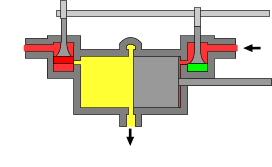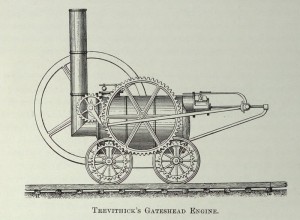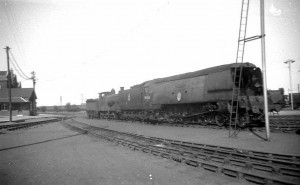By Christian Willey
- How the Steam Engine Works – The steam engine worked by forcing water in a closed container out of the mine shaft, then cold water would condense the steam so that the vacuum could use more of the water out of the shaft through a bottom valve(Gecan/Waterfall, 2007). Fire and water are both used to make the steam engine work, the fire is created in a firebox using coal, which in turn produces steam (How Steam Locomotives Work – Creating Steam, 2009). The steam is then drawn out through a chimney that transfers it to a steam chest and cylinder (How Steam Locomotives Work – Creating Steam, 2009).

Visual of how the steam engine extracts water out of a mine shaft.
by Wikimedia, used under 
Timeline of the Invention of the Steam Engine:
1698 – Thomas Savery invents the steam engine in an attempt to solve the problem of getting water out of mine shafts(Shapiro, 1995). He used the same mechanics used by Denis Papin, who had created the pressure cooker 9 years before (Gecan/Waterfall, 2007).

Visual of Savery’s Steam Engine
by Wavesmikey, used under 
Before the invention of the steam engine, railways existed as horse-drawn carriages, instead of the trains we recognize today.
1803 – Richard Trevithick creates a high-pressured steam engine to power locomotives, based on James Watt’s low efficiency steam engine (Ricci, 2012). He used his high-pressured steam engine to produce the first steam engine to power a locomotive on railways, instead of horse drawn carriages, it could carry 20 thousand pounds of iron, as well as multiple passengers (Ricci, 2012).

Trevithick’s Locomotive
by Wikimedia, used under 
1814 – George Stephenson creates the first locomotive intended for hauling coal and passengers (Historic Figures: George Stephenson, 2014). Stephenson worked for the company Stockton and Darlington, which opened in 1825 as the first public railway (Historic Figures: George Stephenson, 2014).
1841 – The Great Western Railway completed(opened the first 22 miles for use in 1838), attempting to be the “longest, most level, as well as broadest” line of railways used to date according to the creator of the Great Western Railway, Isambard Kingdom Brunel (Webb).
1950-1960’s – The withdrawal of the steam engine in locomotives around the world, steam engines replaced with diesel and electric engines (History of Railroad – Development of Rail Transport). Diesel and electric engines have provided a much faster way of locomotive transport, though it would not be possible without the invention of the steam engine.

1958 Diesel Powered Locomotive
by OLU, used under 
